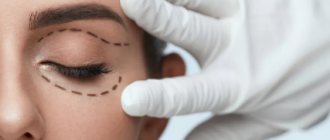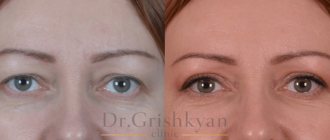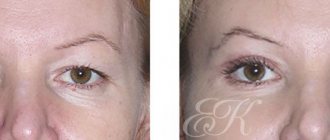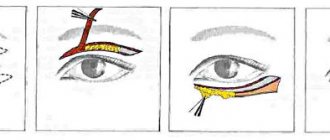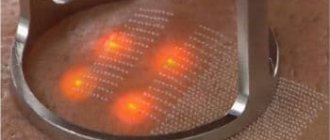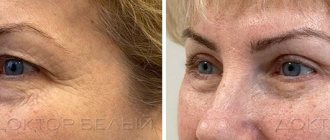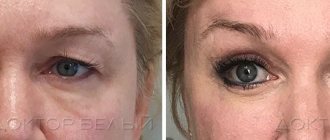Blepharoplasty is an operation to correct the appearance of the upper and lower eyelids. The need for blepharoplasty is due to changes in the skin of the eyelids and weakening of the orbicularis oculi muscles, which results in sagging eyelids and the appearance of fatty “hernias” and numerous wrinkles around the eyes.
The first thing we pay attention to when meeting a person is his eyes. All emotions - joy, anger, irritation, amazement - we can read in the gaze. Or do we just think we can?
Often, due to age-related changes, tissue drooping, the appearance of bags and fatty hernias, a person’s gaze becomes gloomy and tired. Expensive creams and decorative cosmetics are used, but this is not enough.
Eyelid surgery will help get rid of wrinkles, bags and drooping eyelids, making your look open and youthful.
A pleasant advantage of eyelid surgery is that the effect of the operation extends to the entire face, the person looks younger and more attractive. Video of the full progress of the blepharoplasty operation
Meanwhile, blepharoplasty is indicated not only for people in adulthood. Young girls and boys also often suffer from bags and “heavy” eyelids due to their facial structure. In these cases, I also recommend eyelid surgery, which will help make the eyes open and radiant.
Types of blepharoplasty
The operation allows you to restore youth to the skin around the eyes, improve aesthetic appeal, and increase the tone of relaxed muscles. Depending on the indication for use, there are three main types of this operation.
Upper eyelid blepharoplasty
It is used for correction of the upper eyelids (removing sagging, heavy eyelids, fatty hernias and other imperfections). Indications for the use of this operation not only aesthetically spoil the patient’s appearance, but also have a negative effect on vision. Please note: if you have eye diseases, you should definitely consult an ophthalmologist.
Upper blepharoplasty is performed by an experienced and qualified surgeon under general anesthesia. Incisions only 3-5 millimeters long are made in the crease of the eyelid. Through these incisions, the doctor removes excess subcutaneous fat, restores the functionality of the ligaments, and fixes the eyelid muscles in the required position. Excess skin is removed through a straight cut. Plastic surgery of the upper eyelids leaves virtually no visible marks. Various cosmetics will also help you achieve ideal skin. The quality of the operation is clearly visible in the before and after photos posted on this page of our website.
An eyelid lift makes it possible to give the patient a more open and youthful look.
Lower eyelid surgery
Used to eliminate bags under the eyes, swelling, wrinkles, hernias and other pronounced signs of skin aging. Lower eyelid blepharoplasty is prescribed for aesthetic reasons. Such an operation can be carried out using the following methods:
- transcutal - the incision is made in the lower part of the eyelash contour. Through the incision, excess fatty tissue and skin are removed through excision. This plastic surgery of the lower eyelids makes it possible to change the position of the muscles, further strengthening them, tightening the skin, smoothing out wrinkles in the folds;
- transconjunctival - incisions are made from the inside of the eyelid membrane. This lower blepharoplasty is used to effectively remove excess adipose tissue and uniformly redistribute fiber. However, this method is practically useless in eliminating sagging and wrinkles. Therefore, this technique is most often prescribed to patients at a young age.
Circular eyelid blepharoplasty
Used to solve the following problems:
- eliminating external signs of skin aging;
- changes in the natural shape of the eyes;
- correction of existing eye asymmetry;
- elimination of fatty hernias and bags, wrinkles;
- fixes individual problems.
Upper and lower blepharoplasty is the optimal solution for patients who set themselves the goal of slowing down the aging process. This is an excellent and effective way to get rid of age-related changes that have accumulated over 10-15 years of life. The cost of eyelid surgery depends on the complexity of the operation and the amount of work performed. But it is worth considering that only lifting the upper and lower eyelids in combination with a number of other cosmetic procedures (consultation with a professional cosmetologist, resurfacing using laser technology) can give a reliable and guaranteed result. According to studies, the effect of such a procedure can last up to 10 years.
Causes and characteristics of bruises
During blepharoplasty, the blood vessels around the eyes are damaged, causing blue discoloration on the face, and the operated area swells significantly.
The appearance of bruises under the eyes after blepharoplasty directly depends on the level of surgical intervention. A bruise is a collection of blood that occurs as a result of damage to a blood vessel. Bruising is often associated with blood loss during surgery or minor bleeding after blepharoplasty.
The development of bruising under the eyes usually takes 7-10 days. First, there is a pronounced red tint to the bruises, which gives way to purple, after which the treated area turns yellow. The bruises go away slowly, gradually fading away. The duration of the last bruises is observed from 6 to 8 weeks. It depends on the speed of healing and the individual properties of each person’s skin.
You can learn more about eyelid blepharoplasty from the video:
Preparing for surgery
During a consultation with a plastic surgeon, it is worth discussing the timing of the operation and the final result. A few weeks before the appointed date, the patient is required to undergo a number of mandatory tests:
- general blood analysis;
- for the presence of viral diseases (hepatitis, HIV, syphilis);
- heart electrocardiogram;
- coagulogram;
- fluorography.
You also need to check:
- vision;
- presence of eye diseases;
- volume of tear fluid;
- the presence of intractable diseases;
- reaction to the anesthetic drugs used.
Only after consultation with an anesthesiologist is it determined what anesthesia will be: general or local.
Immediately before the operation it is necessary:
- stop smoking for a while - the nicotine contained in cigarettes negatively affects tissue regeneration and the length of the rehabilitation period;
- drink as much water as possible;
- follow the established daily routine;
- limit exposure to ultraviolet rays on the body;
- refuse to use decorative cosmetics and undergo cosmetic procedures;
- completely stop taking any medications, except those approved by your doctor. It is strictly forbidden to use drugs that prevent blood clotting.
Approaches to rehabilitation after blepharoplasty surgery
After completion of the operation and the introduction of general anesthesia during the procedure, the patient must be under close medical supervision for the first 24 hours. Therefore, the patient is placed in a comfortable hospital with qualified and friendly staff for a day. If local anesthesia was used during the operation, then after a certain time the person is allowed to go home on their own.
Eyelid surgery involves the use of special self-absorbing sutures, widely used in cosmetology. However, if prescribed by a doctor, standard sutures can also be used; in this case, they are removed on the third or fourth day after completion of the procedure. All recommendations and prescriptions of the plastic surgeon should be followed in accordance with a specially developed rehabilitation course.
Pain and swelling completely disappear after two weeks. Bruises disappear after ten to fourteen days, but until this point it is recommended to sleep only on your back, with your head slightly elevated. After surgery, you should not take medications used to thin your blood. You should stop smoking and drinking alcoholic beverages for several weeks. For ten days after surgery, you should not apply decorative cosmetics or use contact lenses. For thirty days you should avoid visiting gyms, saunas, baths, and avoid physical activity and prolonged exposure to the sun.
In consultation with a plastic surgeon, it is possible to prescribe special restorative procedures: moisturizing, massage, peeling.
Psychological aspect
A separate problem is the patient’s reaction to the result. As a rule, blepharoplasty has a pronounced rejuvenating effect, and people who decide to resort to it are satisfied. However, other situations also happen: often after a successful operation, the patient, after some time, comes to the doctor again with the intention of bringing his look to perfection.
In some cases, repeated intervention is undesirable, if not contraindicated, either for a certain period of time or at all. Repeated operations tend to provoke more complications, the most common of which is lagophthalmos.
The unnatural look of some world stars who abuse plastic surgery is familiar to many today. Often this is due precisely to the fact that operations on the eyelids have been performed repeatedly, as a result of which the tissues around them have finally lost their natural position and condition.
Of course, no one wants to live with eyelids that don’t close. That is why you should soberly assess your condition and not strive to completely reshape your face.
Take care of your eyes - let them not only please you with youth, but also remain natural and healthy!
Complications after blepharoplasty
Blepharoplasty surgery is performed by a qualified plastic surgeon, which guarantees a high quality of the final result. Possible complications of the procedure are:
- formation of swelling, bruises, hematomas;
- high tear production;
- appearance of double vision (diplopia);
- the appearance of dry eyes;
- formation of conjunctivitis;
- infection in the eyes;
- the appearance of eversion of the eyelid (ectropion), drooping eyelids (lepharoptosis).
Our blepharoplasty surgeon has extensive experience in performing such procedures, so complications are very rare. Most often, the case ends with minor swelling and bruising, which cannot be avoided during any surgical operation. However, even such minor consequences can be completely eliminated during the rehabilitation process. Therefore, we are confident that the results of blepharoplasty will fully meet your expectations.
Let us remind you about contraindications
Blepharoplasty is completely contraindicated in the following cases:
- For hypertension
- Endocrine disorders, incl. hypo- and hyperthyroidism
- Serious diseases of the heart and blood vessels
- Kidney failure
- For diabetes
- For diagnosed eye diseases: glaucoma, xerophthalmia, retinal detachment
You should not have blepharoplasty if less than a year has passed since the previous intervention, or if you have recently undergone a serious illness or major surgery.
Blepharoplasty in Moscow
We are sure that you no longer have a question about where to get blepharoplasty. The Art-Plastic Plastic Surgery Clinic offers optimal conditions for providing such services. Prices for eyelid surgery remain acceptable with a guaranteed high final result of the operation. The quality of work of our qualified surgeons can be assessed using the before and after photographs posted on the page.
Our patients can expect:
- experienced and polite staff;
- the opportunity to be served by the best plastic surgeon in our country;
- modern high-precision equipment from world famous manufacturers;
- high quality consumables;
- provision of a comfortable hospital with round-the-clock service;
- painless rehabilitation in a short time.
You can find out how much an eyelid lift costs by calling the phone number listed on the website or studying the information in a special section.
Why not
Each group of contraindications is its own list of reasons why you should not take risks. If you suffer from high blood pressure (not a rare case, unfortunately, for older people), cardiovascular diseases , this is fraught with problems from several points of view: the risk of complications after general anesthesia increases, the risk of severe bleeding with large blood loss.
Diabetics and people with other endocrine disorders are contraindicated due to their tendency to develop poorly healing wounds and because their blood vessels are very fragile.
And finally, eye diseases are an obstacle to blepharoplasty due to the fact that any manipulation in the periocular area can cause a deterioration in the general condition. After the intervention, swelling, hematomas, and scars always occur, and this can lead to an additional decrease in your visual acuity.



